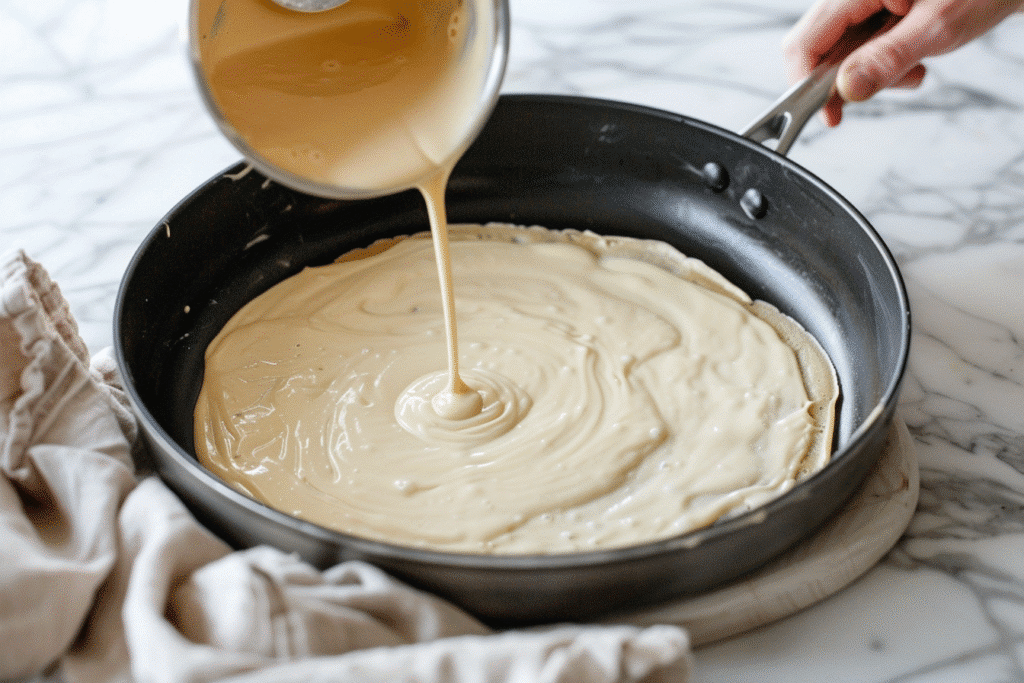Introduction:
Gluten-free crepes are a delightful twist on the classic French favorite, offering the same tender texture and versatility without gluten. Whether you’re looking for a sweet breakfast, a savory lunch, or a light dessert, this easy gluten-free crepe recipe will become a staple in your kitchen. In this guide, you’ll learn the secrets to making perfect gluten-free crepes, explore flour options, and get inspired by mouthwatering fillings.
Part 1: A Gluten-Free Journey to Crepes at Home
There’s something comforting about a warm stack of crepes. I still remember my first crepe recipe gluten free experiment years ago—trying to recreate the paper-thin, buttery delights I once tasted from a street cart near Covent Garden in London.
Back then, I used a basic recipe and a battered pan in my tiny South London kitchen. Fast forward to today—now based in the U.S. and navigating gluten sensitivities in my family—I’ve tested and perfected a crepe recipe gluten free that doesn’t sacrifice flavor or texture.
I scribbled notes in my old notebook and tried different flour blends, discovering that gluten-free crepes can be just as light and tender as the originals. For me, home cooking is my anchor. It connects me to my past and helps me create new traditions.
Making a crepe recipe gluten free has become a cherished weekend ritual—whether layering crepes with ricotta and berries or filling them with sautéed mushrooms and cheese. If you’re starting your own gluten-free journey, know this: delicious crepes are entirely within reach. With a few simple tips (and the right pan), you’ll be flipping them with confidence.
Along the way, be sure to check out other comforting recipes like the best gluten-free banana bread or this easy gluten-free pancake mix guide—perfect companions to your gluten-free crepes.
Print
Gluten-Free Crepe Recipe: Light, Tender, and Delicious Crepes
- Total Time: 30 minutes + 1 hour resting
- Yield: 12–14 crepes 1x
Description
Light, tender, and easy gluten-free crepes perfect for sweet or savory fillings.
Ingredients
1 cup gluten-free flour blend
1/4 tsp salt
1 tbsp sugar (omit for savory)
1 tsp xanthan gum
1 1/2 cups milk
3 large eggs
1 tsp vanilla extract (omit for savory)
3 tbsp melted butter, plus more for the pan
Instructions
1. In a large bowl, whisk together the gluten-free flour blend, salt, sugar, and xanthan gum.
2. In a separate bowl, whisk the milk, eggs, and vanilla (if using).
3. Slowly add the wet ingredients to the dry, whisking until smooth.
4. Stir in melted butter. Let the batter rest for at least 1 hour.
5. Heat a non-stick or crepe pan over medium heat. Brush lightly with butter.
6. Pour 1/4 to 1/3 cup of batter into the pan. Tilt and swirl to coat evenly.
7. Cook for 1–2 minutes until edges lift and bottom is golden. Flip and cook 30–60 seconds more.
8. Stack cooked crepes on a plate and cover with a towel. Serve warm with your favorite sweet or savory fillings.
Notes
For savory crepes, omit sugar and vanilla.
Resting the batter is key for tender, flexible crepes.
Freeze leftover crepes with parchment between layers for up to 2 months.
Try fillings like chocolate and berries, or ham and cheese.
- Prep Time: 10 minutes
- Cook Time: 20 minutes
- Category: Breakfast, Brunch, Dessert
- Method: Pan Frying
- Cuisine: French, Gluten-Free
Nutrition
- Serving Size: 1 crepe
- Calories: 90
- Sugar: 1g
- Sodium: 80mg
- Fat: 4g
- Saturated Fat: 2g
- Unsaturated Fat: 1g
- Trans Fat: 0g
- Carbohydrates: 10g
- Fiber: 1g
- Protein: 3g
- Cholesterol: 50mg
Keywords: crepe recipe gluten free, gluten free crepe recipe, easy gluten free crepes, gluten free pancake recipe
Part 2: Gluten-Free Crepe Batter Basics
Mastering your crepe recipe gluten free begins with the batter. The right flour blend and technique make all the difference between rubbery or chewy crepes and those beautifully thin, soft rounds we all love.
Choosing the best gluten-free flour blend for your crepe recipe
Not all gluten-free flours are created equal—especially when working with a crepe recipe gluten free. For the best results, look for a fine-textured blend that includes rice flour, tapioca starch, and potato starch. Many bakers also add xanthan gum to mimic gluten’s elasticity.
I’ve tested many options, and the most consistent results for a gluten-free crepe recipe came from blends labeled “for baking.” King Arthur’s gluten-free flour remains one of my top choices—it’s reliable, smooth, and perfect for both sweet and savory crepes.
If you prefer homemade blends, try this simple ratio:
- 1 cup white rice flour
- 1/3 cup potato starch
- 1/4 cup tapioca starch
- 1 teaspoon xanthan gum
These light flours help create a batter that spreads evenly in the pan, yielding tender results. It’s the key to making a crepe recipe gluten free that rivals any traditional version.
Tips for mixing a smooth, lump-free batter
To ensure a silky batter, whisk your dry ingredients first. In a separate bowl, combine milk, eggs, and vanilla (for sweet crepes). Slowly pour the wet into the dry while whisking. This gradual method prevents lumps. Finally, whisk in melted butter for richness.
Resting the batter for at least one hour is crucial—it allows the flour to fully hydrate and the xanthan gum to do its job. The result? Crepes that are soft, flexible, and easy to flip.
With your batter ready, it’s almost time to cook. But before you do, you might want to explore this guide to gluten-free baking tips or this homemade gluten-free all-purpose flour mix to expand your gluten-free repertoire.
Part 3: Cooking and Flipping Like a Pro
Cooking a crepe recipe gluten free may seem tricky at first, but with the right tools and a few simple techniques, you’ll be flipping beautiful crepes in no time.
The best pans and tools for gluten-free crepes
Choosing the right pan is key. While traditionalists may use seasoned cast iron, a non-stick 10-inch crepe pan or skillet is ideal—especially when working with delicate gluten-free batter. A thin spatula and a ladle or 1/4 cup measuring cup will also make pouring and flipping easier.
Heat your pan over medium heat until a drop of water sizzles gently. Lightly brush the surface with butter or oil between crepes to prevent sticking.
How to cook, flip, and keep crepes warm
Pour 1/4 to 1/3 cup of batter into the center of the hot pan. Immediately tilt and swirl to coat the pan evenly with a thin layer of batter. Cook for 1–2 minutes, until the edges lift and the bottom turns lightly golden.

Use your spatula to gently loosen and flip the crepe. The second side needs only 30 seconds to 1 minute. Stack cooked crepes on a plate and cover with a towel to keep warm.
Don’t worry if your first crepe isn’t perfect—think of it as a test to season your pan. Once you get the feel, you’ll be flipping like a pro.
For more versatile gluten-free cooking ideas, explore recipes like gluten-free dairy-free recipes or gluten-free chicken recipes—both great complements to a meal featuring gluten-free crepes.
Part 4: Sweet and Savory Gluten-Free Crepe Fillings
Once you’ve mastered cooking gluten-free crepes, it’s time for the fun part: filling them! The versatility of a crepe recipe gluten free means you can go sweet, savory, or a bit of both.
Creative ideas for sweet fillings: fruit, chocolate, and more
Sweet crepes are always a hit for breakfast or dessert. Try filling them with whipped cream and fresh berries or go classic with lemon juice and powdered sugar. For a decadent option, spread a layer of chocolate-hazelnut spread and top with sliced bananas.
Another favorite in our home is a dollop of vanilla yogurt with roasted peaches—a nod to the vibrant fruit flavors I first discovered back in the UK.
You might also like to pair your sweet crepes with recipes like these gluten-free biscuit recipes or this collection of vegan gluten-free recipes for a beautiful brunch spread.
Savory gluten-free crepe ideas: cheeses, vegetables, and meats
Savory crepes are incredibly satisfying for lunch or dinner. Simply omit the sugar and vanilla from your batter for a neutral base.
Fillings like sautéed spinach and goat cheese, ham and Swiss, or roasted mushrooms with herbs work wonderfully. Gluten-free crepes also make a fantastic wrap alternative for dishes like gluten-free chicken recipes.
Don’t forget to experiment with bold flavors—think pesto and mozzarella, smoked salmon with dill cream, or a Mediterranean mix of olives, feta, and roasted peppers. They pair nicely with dishes like these gluten-free dairy-free recipes.
Part 5: Storing and Reheating Gluten-Free Crepes
Gluten-free crepes aren’t just for the moment—you can easily make a big batch and enjoy them throughout the week. Here’s how to store and reheat them while keeping their tender texture.
How to store gluten-free crepes
Allow your freshly cooked crepes to cool completely on a plate, with parchment paper between each one to prevent sticking. Then, transfer them to an airtight container or zip-top bag.
In the refrigerator, gluten-free crepes keep well for up to 4 days. For longer storage, freeze them with parchment between layers. Frozen crepes can last up to 2 months.
How to reheat crepes without drying them out
To reheat refrigerated or frozen crepes, gently warm them in a non-stick pan over low heat for about 30 seconds per side. You can also microwave individual crepes for about 10–15 seconds, but be careful not to overheat, as gluten-free crepes can become brittle.
Having crepes ready in the fridge or freezer makes weekday breakfasts and impromptu desserts simple. You can even turn them into savory wraps for lunches, paired with recipes like pitas gluten-free or ramen gluten-free noodles for variety.
With these tips, your crepe recipe gluten free will become a flexible staple you’ll reach for again and again—perfect for both planned meals and those moments when only a crepe will do.
Part 6: Troubleshooting Your Gluten-Free Crepes

Even experienced cooks occasionally run into hiccups with crepe recipe gluten free attempts. Here are common issues and simple solutions to help you achieve perfect crepes every time.
Why are my gluten-free crepes tearing?
If your crepes are tearing, your batter may be too thick or too thin. A batter that’s too thick won’t spread properly, while a too-thin batter can fall apart. Aim for the consistency of heavy cream. Also, let the batter rest at least one hour to allow the flours and xanthan gum to hydrate—this creates elasticity.
Another cause could be flipping too soon. Wait until the edges lift slightly and the underside is golden before flipping.
Why do my crepes taste rubbery?
Overmixing the batter can lead to rubbery crepes, even with gluten-free flours. Mix the batter just until combined—some small lumps are fine. Also, don’t overcook the crepes. Keep the pan at medium heat and remove each crepe as soon as it’s lightly golden.
How do I keep crepes soft and flexible?
Cover finished crepes with a clean kitchen towel to retain moisture. If you’re making a large batch, stack them with parchment between each crepe.
Remember, your first crepe is often a test run—it seasons the pan and helps you adjust the heat. Don’t be discouraged if it isn’t perfect.
For more gluten-free kitchen confidence, explore these gluten-free biscuit recipes or get creative with gluten-free wonton wrappers for a new savory dish.
With a little practice and these troubleshooting tips, you’ll soon be whipping up gluten-free crepes like a pro.
Part 7: Gluten-Free Crepe Recipe Variations Around the World
One of the joys of cooking a crepe recipe gluten free is discovering how different cultures put their own spin on this versatile dish. Here’s a quick tour of crepe-inspired creations from around the globe—all of which can be made gluten-free with a little adaptation.
French Crêpes (Crêpes de Froment & Crêpes de Sarrasin)
The classic French sweet crepes (crêpes de froment) are made with wheat flour, but easily converted using a gluten-free blend. For savory French crepes, try using buckwheat flour (crêpes de sarrasin), which is naturally gluten-free and lends a hearty, nutty flavor. Fill with ham, cheese, and egg for an authentic Breton galette.
Swedish Pancakes (Pannkakor)
Lighter and smaller than French crepes, Swedish pancakes are traditionally served with lingonberry jam and whipped cream. A gluten-free blend with potato starch works well for these delicate, slightly sweet pancakes.
Russian Blini
Thicker and smaller than crepes, blini are often made with buckwheat flour and served with savory toppings like smoked salmon and sour cream. Using a gluten-free buckwheat blend keeps this traditional favorite accessible for gluten-free eaters.
Japanese Okonomiyaki
While not technically a crepe, okonomiyaki is a savory Japanese pancake filled with cabbage, meats, and seafood, topped with a tangy sauce and mayo. For a gluten-free version, use a rice flour and potato starch blend.
Vietnamese Bánh Xèo
These crispy turmeric crepes are made from rice flour and coconut milk, making them naturally gluten-free. Filled with pork, shrimp, and bean sprouts, they offer a delightful crunch and rich flavor.
Experimenting with global crepe styles can add excitement to your gluten-free kitchen. Pair your creations with recipes like vegan gluten-free recipes or gluten-free dairy-free recipes for a well-rounded meal.
FAQ
What is the secret of a good crepe?
The secret to a good crepe lies in a thin, well-rested batter and the right pan temperature. Letting the batter rest allows the starches to hydrate, resulting in tender, flexible crepes. Use a non-stick pan or a seasoned crepe pan, and keep your heat at medium for even cooking.
How to make crepe GF?
To make a crepe recipe gluten free, substitute traditional flour with a gluten-free flour blend that includes rice flour, potato starch, and xanthan gum. Follow a classic crepe method—combine flour with eggs, milk, and butter, and rest the batter before cooking.
Does crepe have gluten?
Traditional crepes do contain gluten because they’re typically made with wheat flour. However, gluten-free crepes replace wheat with alternative flours, making them safe for those with gluten sensitivities.
What is the difference between French and Swedish crepes?
French crepes are typically larger, thinner, and more versatile—used for both sweet and savory fillings. Swedish crepes are smaller, slightly thicker, and often served with jam and whipped cream. Both can be adapted to a crepe recipe gluten free with excellent results.
Conclusion
A great crepe recipe gluten free opens the door to countless delicious possibilities. Whether you fill yours with chocolate and berries or savory vegetables and cheese, gluten-free crepes are a simple way to bring a little joy to your table.
From my days experimenting in a London kitchen to my family brunches here in the U.S., gluten-free crepes have become a cherished part of my home cooking. I hope this guide inspires you to try your own versions and create new memories along the way.
If you’re ready to explore more, be sure to visit our latest recipes like these ramen gluten-free noodles or gluten-free wonton wrappers—perfect complements to your gluten-free cooking adventures.
For more gluten-free crepe ideas and sweet or savory inspiration, follow us on Pinterest and join our community on Facebook—we share fresh recipes and cooking tips every week!


